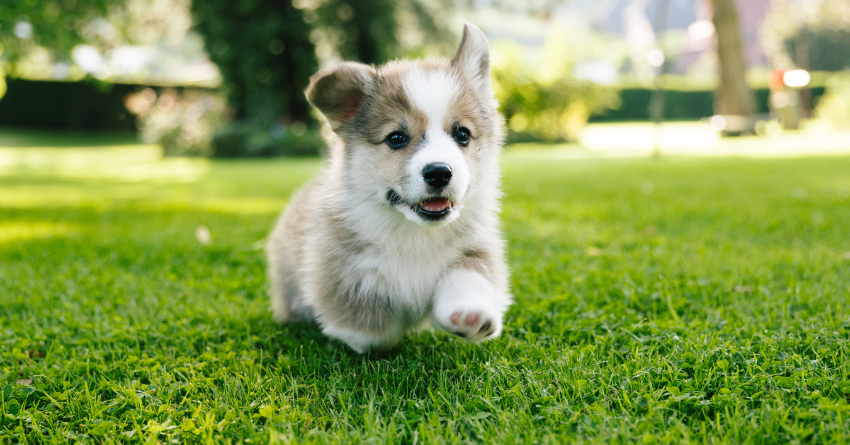As most pet owners know, potty training a puppy can be a challenging process that requires patience, trial and error, and plenty of cleaning supplies — especially when you’re first getting started!
Dogs are naturally clean animals, and puppies will try very hard to avoid soiling their eating or sleeping spaces. But it can take a while for them to understand that bathroom breaks are always supposed to happen outside.
In this article, we’ll cover some expert tips and tricks new puppy owners can use when potty training their furry friend.
Why Can House Training a Puppy Be So Difficult?
Miscommunication
One of the most common challenges to potty training a puppy is miscommunication. Puppies don’t inherently understand what’s expected of them. They rely heavily on their owners to teach them where and when it’s appropriate to go to the bathroom.
For example, if a pet parent takes their puppy to a different spot each time they go out, rather than to a designated potty spot, the puppy may get confused, which can lead to accidents in the house.
To avoid this, be consistent with your training cues and locations. Try using a specific phrase like “go potty” every time you take your dog to their bathroom spot and praise them when they go to help them associate the phrase with the action.
Anxiety or Fear
Anxiety and fear can have a large impact on a dog’s potty training progress. A pup who is stressed or scared may have more accidents due to their heightened emotional state. Some common causes of anxiety among dogs include new environments, loud noises, or separation from their owners.
Try to establish a safe and comfortable environment for your puppy using these training tips:
Create a designated quiet area in your house where your puppy knows they can relax.
Use positive reinforcement to reward calm behavior, such as giving them pets or a treat.
Gradually expose your puppy to new experiences to build their confidence.
Avoid scolding or punishing your puppy for accidents, as this can increase their anxiety and lead to even more accidents.
Irregular Schedules
For more effective potty training, maintain a regular schedule. Dogs of all ages thrive on routine, so consistent feeding schedules and potty breaks help them learn when and where to go. Here are some ways to help establish a consistent routine:
Feed your pup at the same times each day.
Take them out for bathroom breaks at regular intervals, such as after meals, naps, and play sessions.
Keep a journal of your puppy’s potty habits to identify patterns and adjust the schedule as needed.
If you’re struggling with the potty training process, try taking your puppy out more frequently, especially during the daytime hours when they are more active.
Your Home’s Location
If you live in a larger city or an apartment with less access to green spaces, it can complicate potty training a bit. It may take longer to get to an appropriate spot for your puppy to relieve themselves, which can increase the chance of accidents.
To work through this challenge, follow these tips:
Try to take your puppy out as soon as possible when you notice signs they need to go.
If you have limited access to outdoor spaces, consider using indoor potty solutions like puppy pads or a small indoor grass patch.
Be patient and understanding, and remember that it’s normal for potty training to take longer in a more complicated setting.
Signs That Your Puppy Needs a Potty Break
Puppies will give signals that they are looking for somewhere to go to the bathroom — you just need to know what to watch out for and act right away. Some of these signals include:
Sniffing
Circling
Whining
Barking
Restlessness or inability to sit still
Increased activity (like getting up suddenly and wandering around the house)
Heading to the door
What To Do If Your Puppy Has an Accident
If you catch your puppy about to go potty inside (but before they actually do), try to pick them up and carry them outside right away. It’s important to be swift but calm to avoid frightening your pup.
And if you catch your puppy after the act, it’s too late to fix the issue this time around. Avoid punishing them, because they can’t understand that they’re in trouble for their choice of bathroom place. You’ll just seem unpredictable and scary.
Accidents are an inevitable part of potty training, but be sure to utilize enzymatic cleaners to remove odors. This can help ensure your puppy loses the scent of where they went last time and hopefully prevent them from going in the same spot again.
How To Potty Train a New Puppy the Right Way
Establish a Routine
The younger your puppy, the less time they can hold it before they have to really go. For example, most puppies have to poop about 5–30 minutes after eating. And dogs often get thirsty after eating and drink a bunch of water at once, making a pee accident also more likely.
As a general rule, you should take your puppy outside after every meal, after waking up, and after playtime. While they are very young (8–10 weeks of age), aim to take them out every 20–30 minutes or so as well.
As they get older, you can take them out less frequently, but you’ll still need to do more than just open the door and let them out. Many dogs get excited by all the scents outside, squirrels to chase, and grass to eat, which may mean they don’t go potty right away. Try to supervise them to ensure they do their business.
You should also keep in mind that, for a puppy, a normal-sized home is a very large, confusing space. To them, this new home is so vast, with so many places to eat, play, and potty, that it can be difficult for them to understand that going potty anywhere isn’t allowed.
To make the transition easier, try to make your home smaller by only allowing your puppy in certain rooms. You can close doors and use baby gates for this puppy-proofing process.
It also can be helpful to use a dog crate to responsibly crate train your puppy and give them a safe space that’s theirs — and that they don’t want to soil.
Use Positive Reinforcement
Reinforcement in house training means that every time your pup gets it right (goes outside instead of inside), they get a reward. Rewards can include positive verbal praise, treats, or a toy. For example, every time your pup goes potty outside, tell them what a good boy or girl they are and offer a treat.
And since reinforcement must come immediately after the dog potties, you have to be outside with them every time. While you don’t want to interrupt your puppy, offering positive reinforcement as soon as they finish helps them associate the action with the reward.
This can be a commitment and might require some strategy. Consider keeping a baggie of low-calorie treats right by your back door or right outside your door for easy access.
Pair Cue Words With Hand Gestures
In addition to establishing a routine and providing positive reinforcement, pair cue words with hand gestures to encourage your pup to go potty. Timing is really important with this strategy. Dogs do well with a verbal cue, hand gesture, and small, low-calorie reward all at the same time.
Use words that you don’t commonly use otherwise, like “potty” or “go potty” or “pee-pee time.” If you choose a more common phrase or word, it may confuse your dog. Once a word or phrase is established, use it, let your dog do their business, and then give positive praise plus a reward immediately.
Stay Consistent With Your Responses
Consistency in all areas of potty training a puppy is vital, so be sure to create your go-to responses and stick with them. This can help increase the number of successful potty trips and decrease accidents in the house.
It’s also really important to maintain this consistency with everyone in your household and anyone else who lets your dog out to go potty (dog walkers included). Share the phrasing and technique you’ve established with everyone so your dog doesn’t get confused if someone else takes them to potty.
Consider Your Puppy’s Breed and Age
Finally, think about your puppy’s breed and age when developing your toilet training strategy to help manage your expectations throughout the process. Unfortunately, some breeds are notorious for being very difficult to toilet train, especially small, stubborn breeds like pugs and Yorkies.
Age also plays a factor, as dogs can hold their bladder longer as they get older. Try to take your puppy out for potty time on a schedule that’s based on an hour per month of age. In other words, a puppy who’s only two months old should go out every two hours.
If, after following these tips, you’re still struggling with potty-training your dog, make sure they’re physically healthy. It may seem like a dog is having trouble grasping potty concepts when they actually have a UTI that prevents them from holding in their urine. As always, contact your veterinarian if you have any doubts.
Are Puppy Pads Ever Recommended for Long-Term Potty Training?
Puppy pads — also known as pee pads or potty pads — are pads made of absorbent layers of material that can help with puppy messes. You can use them to potty train a puppy or as a backup for dogs who may be inside for long periods of time or are sick, elderly, or disabled.
These potty training pads can be an extremely helpful tool for pet parents experiencing the puppy blues or for those who live in a large city where it takes longer to get outside.
You can start by training your dog to associate the puppy pad with using the bathroom and then slowly move the pad closer and closer to the door. As with outdoor toilet training, puppy owners should also pair verbal cues, hand cues, lots of praise, and a reward with the pad training.
What Treats From The Honest Kitchen are Excellent Rewards for Puppy Potty Training?
Your puppy will go through a lot of treats during potty training, so make sure they’re healthy, low-calorie, and of course, delicious! A great starting point for healthy, low-cal treats is The Honest Kitchen — our human grade treats are full of thoughtfully sourced, whole-food ingredients that dogs love.
We recommend the following training treats:
Parmesan Pecks: These training-friendly treats are made of cage-free duck and real cheese, and they’re an ideal (and tasty) biscuit for small and medium-sized dogs.
Meaty Littles: For dogs with a taste for surf and turf, these treats combine ranch raised beef and wild caught salmon for a super craveable taste that supports strong muscles and brain health.
Puppy Clusters: A third option for training treats is The Honest Kitchen’s kibble-alternative puppy food. These whole grain chicken clusters include cage free chicken, oats, veggies, salmon oil, and probiotics in perfectly bite-sized pieces that are ideal for training.
Potty Train Your Puppy With Tasty Rewards From The Honest Kitchen
Raising a puppy is a tough job, but you’ll be well-rewarded with plenty of wet-nose kisses, furry snuggles, and unconditional love. Consistency, positive reinforcement, and a regular schedule will go a long way toward teaching your puppy good habits, as will remembering that they’re just a baby who’s still learning.
So, as you deal with the inevitable range of emotions and messes during potty training, keep these tips and tricks in mind — and keep some tasty rewards from The Honest Kitchen at the ready.
Check out The Honest Kitchen’s full puppy food collection to find the perfect treat for your new furry friend.




